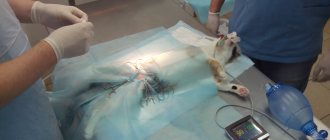May 19, 2020
Castration is a surgical procedure during which a veterinarian removes the testes from a cat. However, this procedure can be performed without surgery.
To understand all the intricacies, you need to learn more about the types of procedures and methods of implementation.
Should a cat be neutered? Pros and cons of the operation
Pet owners think about the sterilization procedure after young cats begin to mark their territory. The main advantage of castration is the disappearance of the desire to mate. However, the operation has many other advantages:
- Elimination of aggressive, restless behavior. The testes produce special hormones that force the cat to look for females and defend its territory from strangers. Even if the animal lives in an apartment and has never seen other cats, the owners may notice the pet’s constant anxiety. If two males meet in the same territory, fights will begin. Excessive testosterone production can lead to the cat attacking its owners.
- Prevention of diseases. After castration, a cat will not develop a testicular tumor, since this organ will be completely removed.
- Reducing the risk of the animal running away. Even if a cat is very attached to its owners, the natural instinct of reproduction can take precedence over reason. The animal will try to escape every time it smells a female. Domestic cats are poorly adapted to outdoor life. After castration, the animal is unlikely to want to leave a comfortable and safe place.
- Elimination of unpleasant odors. Kittens' urine does not have a strong odor. During a cat's puberty, a special secretion is mixed into the urine. Hormones force the male to “mark” his territory and attract females. People find this scent very unpleasant. After castration, the cat's urine will not have a strong odor. The pet will only go to the litter box and not mark any surfaces in the house.
- Increased life expectancy. According to worldwide statistics, neutered pets live longer. They do not experience stress from heat. This makes their nervous system calmer.
Castration, like any other surgical operation, has its drawbacks. It has been proven that castrated cats become passive. Lack of activity leads to obesity, which in turn contributes to the development of diabetes, urocystitis and urolithiasis, and also provokes joint problems.
Fortunately, most unpleasant complications can be prevented by providing the animal with proper nutrition. In any case, the benefits of castration outweigh any possible disadvantages. The main thing is to entrust the health of the animal to an experienced veterinarian.
Advantages and disadvantages of castration
Carrying out surgical intervention is not an empty desire of the owner to turn a pet mustache into a soft toy. Such interference in the body has positive and negative sides. Among the advantages of removing the gonads are:
- Reducing manifestations of aggression on the part of the pet. During the period of searching for a female, he becomes conflicted, nervous, and may attack or hiss at a person. After excision of the testes, there will be no need for sexual hunting, and aggression will be reduced to a minimum.
- Reducing unpleasant physical behavior, such as obsessive loud meowing to attract a partner. The cat will not have the need to mark its territory.
- There will be no attempts to escape from home and go on a long journey. The pet will now stay at home or in a well-known yard with great pleasure. He won't want to go out looking for a bride.
- Prevention of urological diseases. Thus, males, thanks to the removal of the gonads, are completely free from testicular cancer or prostate adenoma.
Owners of male cats need to understand that castration of a cat at any time is not a panacea for all health or behavioral problems. Each surgical intervention involves a number of difficulties:
- metabolic disorders and the development of obesity;
- impossibility of using a male for mating;
- probable complications in the form of the development of urolithiasis.
In fact, there are few hassles after the process, and some of them are easy to deal with. To avoid problems with digestion and salt deposition, it is enough to reduce and adjust the animal’s diet.
When should a cat be neutered?
There are no strict deadlines for castration of cats. Most specialists do not perform surgery on kittens under four months of age. Optimal time for surgery: 6-9 months.
Castration of a cat at an early age
Veterinarians do not recommend sterilization for cats under six months of age. But if the cat shows signs of sexual activity earlier, then castration will be carried out immediately after the animal reaches five months of age.
Surgeries at an early age will not affect weight loss or skeletal underdevelopment. These features are laid down in the genotype, which determines the constitution of the pet.
Carrying out surgery at the age of 7-9 months
It has been proven that cats that have reached the age of 6-9 months tolerate castration best. The animal enters adolescence and begins to show interest in females. The cat may start meowing throughout the day. It is at this age that a pet experiences a hormonal surge, which is negatively reflected in the smell of urine.
The cat also gains sufficient body weight to tolerate anesthesia normally. Some veterinarians advise bringing your cat for surgery long before physiological changes develop.
Carrying out surgery in adulthood
Young cats under 3 years of age tolerate castration quite well. However, it is worth considering that adult males who are already accustomed to marking territory can continue to do so even after castration. It will take at least a month to level out your hormonal levels.
About 5% of animals will continue to mark territory for the rest of their lives. Also, some castrated “untied” cats may try to have sexual intercourse with a female. Veterinarians consider this behavior to be a habit: the cat is simply repeating already established patterns.
Technically, cats over 3 years old can also be neutered. However, in adult animals the risks of anesthesia increase. Such an animal must first be examined: undergo blood tests and undergo a screening ultrasound of the heart.
General information
Castration is a procedure aimed at suppressing the sexual function of an animal. Not in all cases this requires surgical removal of the cat's testes.
There are several types of sterilization when a scalpel is not required (or is required, but for other purposes):
- Medication. In this case, a special cartridge is implanted under the pet’s skin, which gradually releases substances that suppress libido. One of the most popular and effective remedies is Suprelorin.
- Chemical. Substances that suppress the growth and development of glandular tissue cells are injected directly into the testes. This type of sterilization is especially common in India, where a 10% calcium chloride solution is used for the procedure.
- Radiation. The testes are irradiated under a source of directed gamma radiation.
All three of these types are especially recommended by veterinarians to owners of older cats, since these methods are the least traumatic.
However, due to the low prevalence of some of them (chemical castration) and the high cost of others, surgical sterilization is still the most common. It is cheap, effective, and takes very little time. True, its implementation in the case of four-year-old cats and older is fraught with some difficulties.
Preparing a cat for castration
The most important rule for the owner: remain calm throughout the entire period of preparation for the operation. Pets understand human emotions very well. The pet will feel anxious and begin to hide and behave aggressively. It is necessary to maintain a fasting diet for 6-8 hours before anesthesia. Water can and even should be left available.
If castration will be carried out by a veterinarian who has not previously examined the cat, it is necessary to prepare information about vaccinations, medications and diseases that the animal has suffered. The owner will also be asked to sign a consent form for the use of anesthesia, an information sheet regarding possible complications after the operation.
How to prepare an animal for surgery?
To ensure the normal course of the operation, the veterinarian prescribes a set of preliminary tests: ultrasound, blood test, consultation with a cardiologist, vaccinations according to age. These measures are especially important for older animals, since the aging process leads to the accumulation of irreversible changes in the body.
The entry of food into the animal’s body before surgery should be excluded. The cat can be fed for the last time twelve hours before surgery, and given water no less than three hours before. The intestines must be empty at the time of surgery, otherwise the anesthesia will cause uncontrollable vomiting.
Anesthesia for castration of a cat
To choose the optimal method of pain relief, the veterinarian will examine the cat and take measurements of vital signs:
- temperature;
- heart rate;
- blood pressure.
The veterinarian will perform surgery only if he receives confirmation that the cat is healthy enough to recover from anesthesia.
Most often, the animal is sedated using an injection. An intravenous catheter is inserted through the shaved area of the paw.
Inhalation anesthesia
Most cats are given anesthetics by injection or intravenous catheter. After falling into a light sleep, the anesthesiologist will insert an endotracheal tube through which anesthetic gas will be administered.
The animal will also be connected to equipment that monitors heart rate, breathing, and blood pressure. Most veterinary clinics use an inhaled drug - isoflurane or sevoflurane.
Non-inhalational anesthesia
The most common type of sedation and analgesia is a combination of drugs. The operation to remove the testes is quite simple and takes approximately 10-15 minutes.
Most often, this manipulation uses a combination of a sedative intravenous drug and a local anesthetic, which is injected directly into the testes themselves for pain relief.
Choosing a cat sterilization method
Sterilizing a cat leads to a decrease in the amount of sex hormones produced by its body. What is the difference between castration and sterilization, what is the difference, description below?
Ovariectomy (sterilization) and ovariohysterectomy (castration) . What does surgical sterilization of cats mean - removal of the ovaries, castration - removal of all genital organs. The first method is chosen for young cats that have not yet given birth, since the likelihood of damage to the uterus is low for them. The result of the operation is the emotional comfort of the pet and its owners, reducing the risk of neoplasms, and will help get rid of the marks.
Veterinarians advise complete castration with removal of the uterus. This is the most reliable way to regulate sexual heat, allowing you to protect the cat from complications associated with the development of purulent inflammation of the uterus.
Tubal ligation (occlusion) . This method removes reproductive ability, but leaves hormonal levels intact. The cat's sexual behavior remains the same after surgery, so such operations are performed infrequently.
Temporary castration with medication. If the owner wants to temporarily stop the cat’s hormone production, an implant is inserted under the cat’s skin. It performs the task of blocking hormones for 3 years. After this period, the cat will again be able to give birth.
Methods of castration of cats
There are several options for sterilizing males. In modern veterinary clinics, testes are most often removed surgically. However, some systemic diseases may make any intervention impossible.
Nuances of classical surgery
After administering anesthesia, the surgeon will make two incisions directly on the animal's scrotum. Next, the specialist removes the testes, placing biological nodes on the blood vessels. The incisions are treated with an antiseptic solution. Sutures, as a rule, are not applied.
Medical (chemical) castration
If anesthesia or sedation is contraindicated, your veterinarian may administer medications to stop testosterone production. The advantages of this method include reversibility and low risk of complications.
Chemical castration involves inserting an implant under the cat's skin. The testes gradually atrophy, that is, decrease in size. The animal's behavior will change within 4-5 weeks after the procedure. The duration of the effect varies from 6 to 12 months.
After the end of the implant, the production of hormones is restored, which also leads to the return of the size of the testes and the manifestation of sexual desire.
Features of castration of a cryptorchid cat
If one or two testes do not descend into the scrotum, the cat is diagnosed with cryptorchidism. The shedding process must be completed before the kitten is 6 months old.
The nuances of the operation directly depend on the location of the testes. They may be located under the skin or in the abdominal cavity. If one or both sex glands remain in the abdominal cavity, then to perform the removal procedure, abdominal surgery is performed through one incision.
A little about castration
In cats, puberty occurs quite early. At 4-5 months, the kitten has not yet lost its milk teeth, but it can already fertilize the female. A more correct term is castration, since sterilization implies the elimination of the ability to reproduce, but with the preservation of sexual activity. Castration is the complete removal of the testes from the scrotum.
Before the operation, the animal is given general anesthesia and local anesthesia, after which it is attached to the operating table. The hair at the site of the intervention is shaved and the surgical field is disinfected.
After preparation, the surgeon dissects the scrotum to avoid bleeding, ties the vessels leading to the testes, after which they are cut off. The scrotal cavity is treated with antiseptics, and the wound is sutured. The duration of the procedure ranges from 30 minutes to an hour.
Possible complications after surgery
Surgical removal of the testes is a fairly simple operation, but in rare cases complications can occur. Veterinarians usually assess the animal’s health before the procedure begins and inform the owner about the possible development of the following side effects:
- licking of incisions on the scrotum and inflammation of wounds
- deterioration of general condition
In order to prevent the development of complications, it is necessary to monitor the cat during the first 24 hours after surgery and follow the recommendations of the veterinarian.
Features of surgery
Since the genitals of an adult cat are already fully formed, it is strictly forbidden to castrate him using a closed surgical method. We are talking about a surgical technique in which the serous membrane of the scrotum is tightened with a ligature. It is almost impossible to perform this operation efficiently in an adult animal. If even a slight blood flow continues to the “tightened” organs, swelling, inflammation will develop, and gangrene and necrosis may also develop. All this is fraught with the death of the pet from sepsis.
It is not recommended to castrate “over-aged” cats at home.
Since (compared to kittens) there is a high risk of complications, it is better to do this in a clinic. We recommend that you arrange an appointment for the operation in the morning, having first taken that day off. In this case, you can take the operated cat home and quietly monitor him all day. In addition, the animal will be much less nervous, constantly seeing the owner nearby.
If for some reason the operation cannot be scheduled in the morning, it is better for the veterinarian to perform it in the evening. In this case, it is recommended to leave the cat in the clinic overnight. He will be under constant supervision of specialists and if something goes wrong, they will be able to quickly provide your pet with the necessary medical care.
How to care for a cat after castration
After the operation, the doctor will give individual recommendations based on the animal’s condition. However, the standard set of care instructions is approximately the same.
- Provide constant supervision to your pet. If the operation is successful, full recovery of health will take only 1-2 days. It is advisable to keep an eye on the cat until complete rehabilitation. It is important to exude confidence and remember to pet and encourage your pet.
- Place a protective collar around the cat's neck. It is very important to ensure that the cat does not lick the incision area. An Elizabethan collar will prevent the animal from licking the damaged area. Treatment of wounds is usually not required.
- Provide the animal with water and food. You can feed him wet food after surgery, since the cat was previously on a starvation diet. To get him interested in food, it is best to give him a bag of wet food or canned food for neutered cats. This will quickly replenish the balance of micro and macroelements.
Who needs it
It is often said that if an animal is on its own, then there are no problems for the owners. The cat looks for his own adventures, fights for females, and realizes his sexual instinct. Sometimes he dies in fights, plus he actively contacts other animals, risking contracting infections. If he sits at home, then serenades cannot be avoided. And don’t think that the cat will sing only in the spring. But this is not the most unpleasant thing. Much worse are the marks that mature animals use to mark their territory. They have an appropriate smell and are very difficult to remove. It is simply impossible to predict the location that will be attacked. Non-neutered cats are equally successful at marking sofas, the owner's shoes, and corners of rooms.
Behavior of an operated cat
A sterilized British cat will no longer go into heat. Otherwise, the character of the animal will remain the same with correction (changes) towards greater balance and obedience.
The Briton will continue to hunt, play and communicate with other pets and family members as before.
The cessation of sex hormone production leads to a gradual increase in appetite, resulting in obesity. You should consider a balanced diet for the animal, including specialized low-calorie food for castrated animals.
Character and temperament
Is it possible to castrate a cat at 5 years old if the only problem is his playfulness and mobility? No, in this case it is better to leave everything as is. It is a myth that after removal of the testes the animal becomes calm and sleepy. Just like people, cats have different personalities and temperaments. If your pet is active and playful by nature, then it will not become a sofa ottoman.
When surgery doesn't make sense
Quite often, by removing the testes, owners want to correct the behavior of their pet. But in this case we are talking about an adult animal with already formed behavioral habits. Therefore, when a veterinarian is asked whether it is possible to castrate a cat if he is 5 years old, he must explain to the owner that this is not a magical procedure that will make their pet calm, affectionate and flexible in one moment. It makes no sense to remove the testes if:
- The pet constantly asks to go outside. Here it’s not even about sexual activity, it’s just more interesting there than at home.
- The cat is aggressive. If this is due to the disposition and habits of the animal, then the operation will not help in any way.
- The animal has been pooping everywhere for a long time. After the operation, it will no longer leave marks that are needed to attract females. But such a procedure cannot accustom him to the tray. If a cat has chosen a place for the toilet, then it is usually very difficult to retrain it.
Anatomical nuances
As you know, the testes are located in a small skin “pouch” located under the anus behind the cat’s penis. This “pouch” of skin is called the scrotum or scrotal pouch. It is from this that the veterinary surgeon will cut out the testes. The latter are connected to the abdominal cavity by vessels. They, together with the spermatic cords, enter the pelvic cavity through openings called the inguinal canals. After passing from the abdominal cavity through the inguinal canal, the vessels and ducts, together forming the cord, pass into the scrotal cavity.
Some of the thick connective tissue lining the animal's abdominal cavity also passes through the inguinal openings and lines the inside of the scrotal sac. Scientifically, this tissue is called the tunica vaginalis. Among other things, this structure releases a certain amount of fluid that performs a lubricating function. Thanks to this, the testicles can move inside the scrotal sac.
How will behavior change?
Most likely not. Since the cat is already an adult, the psychosomatic characteristics of its behavior have already formed.
You should not expect that a neutered pet will “like magic” stop marking its territory. If this habit goes away, it won’t go away right away.
With aggression, unfortunately, things are the same. If the animal was already aggressive by the age of four, you should not wait for its transformation after castration. Practice shows that this practically never happens.
If your pet is “angry” and as a result you want to castrate him, it is better to take the cat to the veterinarian: perhaps the reason for his behavior does not lie at all in an excess of sex hormones.
Features of the procedure
When a cat is neutered, his testes are removed. Thus, the animal stops producing hormones and stops sexual activity. If a pet is diagnosed with cryptorchidism (one of the testicles is not in the scrotum), then the sunken testicle is cut out. In addition, such individuals are not allowed for breeding. But it should be remembered that hormones do not disappear from the body immediately after the procedure. Therefore, the cat’s hormonal background will become stable only in a month. Another way of performing the procedure is a vasectomy, in which the cat is spayed. With it, the veterinarian does not touch the testes, but cuts the canal next to them. Thus, sperm does not enter the seminal duct, and the cat’s hormonal levels do not change.











